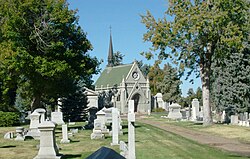
The Boston Brahmins, or Boston elite, are members of Boston's historic upper class. From the late 19th century through the mid-20th century, they were often associated with a cultivated New England accent, Harvard University, Anglicanism, and traditional British-American customs and clothing. Descendants of the earliest English colonists are typically considered to be the most representative of the Boston Brahmins. They are considered White Anglo-Saxon Protestants (WASPs).

Edwin Carl Johnson was an American politician of the Democratic Party who served as both governor of and U.S. senator from the state of Colorado.

Rock Creek Cemetery is an 86-acre (350,000 m2) cemetery with a natural and rolling landscape located at Rock Creek Church Road, NW, and Webster Street, NW, off Hawaii Avenue, NE, in the Petworth neighborhood of Washington, D.C., across the street from the historic Soldiers' Home and the Soldiers' Home Cemetery. It also is home to the InterFaith Conference of Metropolitan Washington.

Mount Pleasant Cemetery is a historic rural cemetery in the North Ward of Newark in Essex County, New Jersey, United States. It is located on the west bank of the Passaic River in Newark's Broadway neighborhood, opposite Kearny. It occupies approximately 40 acres and was designed by Horace Baldwin.
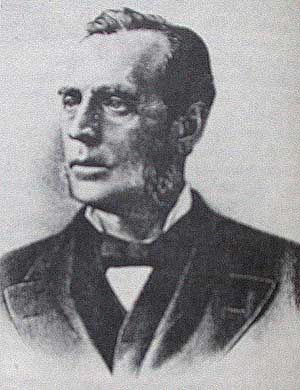
William Austin Hamilton Loveland was a U.S. railroad entrepreneur and businessman in the late 19th century. An early resident of Golden when it was the capital of the Colorado Territory, he was one of the founders of the Colorado Central Railroad and a principal figure in the early history of Colorado. As president of the Colorado Central, he was instrumental in the expansion of the railroad network into the mining communities of Colorado. For much of the 1870s Loveland waged a fierce struggle with Union Pacific investors for control of the Colorado Central.

Mount Olivet Cemetery is a 206-acre (83 ha) cemetery located in Nashville, Tennessee. It is located approximately two miles East of downtown Nashville, and adjacent to the Catholic Calvary Cemetery. It is open to the public during daylight hours.
William White may refer to:

Thomas MacDonald Patterson was an American politician and newspaper publisher who served as a member of the United States Senate and United States House of Representatives from Colorado.

Alma Bridwell White was the founder and a bishop of the Pillar of Fire Church. In 1918, she became the first woman bishop of Pillar of Fire in the United States. She was a proponent of feminism. She also associated herself with the Ku Klux Klan and was involved in anti-Catholicism, antisemitism, anti-Pentecostalism, racism, and hostility to immigrants. By the time of her death at age 84, she had expanded the sect to "4,000 followers, 61 churches, seven schools, ten periodicals and two broadcasting stations."

Lawrence Cowle Phipps was a United States Senator representing Colorado from 1919 until 1931.

Eugene Donald Millikin was a United States senator from Colorado who served as Senate Republican Conference Chairperson from 1947 to 1956.
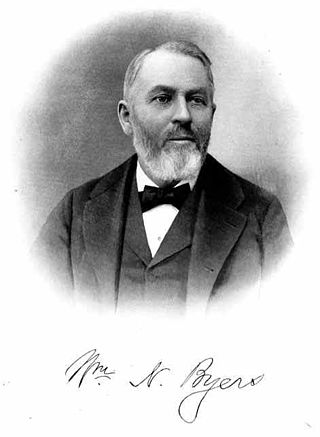
William Newton Byers was a founding figure of Omaha, Nebraska, serving as the first deputy surveyor of the Nebraska Territory, on the first Omaha City Council, and as a member of the first Nebraska Territorial Legislature.

Karl Cortlandt Schuyler was an American attorney and politician from Colorado. A Republican, he was most notable for his service as a United States senator from 1932 to 1933.

Ray Bridwell White was the son of Alma White, the leader of the Pillar of Fire Church in Zarephath, New Jersey. He was nominated to be a Bishop shortly after his mother died in 1946, but was too ill to attend the ordination ceremony and died shortly thereafter.

The Pillar of Fire International, also known as the Pillar of Fire Church, is a Methodist Christian denomination with headquarters in Zarephath, New Jersey. The Pillar of Fire Church affirms the Methodist Articles of Religion and as of 1988, had 76 congregations around the world, including the United States, as well as "Great Britain, India, Liberia, Malawi, Nigeria, the Philippines, Spain, and former Yugoslavia".

Arlene Hart White Lawrence was a bishop and the third president and general superintendent of the Pillar of Fire Church, a Protestant denomination which in 1966 operated church congregations, missionary homes, radio stations, publishing operations, farms, schools and colleges from 54 properties around the world. The denomination was founded in Denver, Colorado, by her grandmother, Alma Bridwell White, the first woman to become a bishop in the US. She believed that "activities such as gambling and dancing take time from the really important activities of life". She was the president of all three church radio stations, KPOF in Westminster, Colorado; WAWZ in the Zarephath section of Franklin Township, Somerset County, New Jersey ; and WAKW in Cincinnati, Ohio.
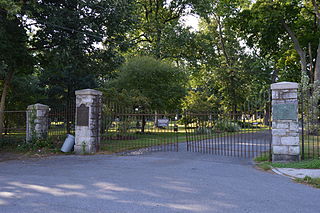
Harrisburg Cemetery, sometimes referred to as Mount Kalmia Cemetery, is a prominent rural cemetery and national historic district in Harrisburg, Pennsylvania, located at 13th and Liberty streets in the Allison Hill/East Harrisburg neighborhoods of the city. It was founded in 1845, though interments took place for many years before.
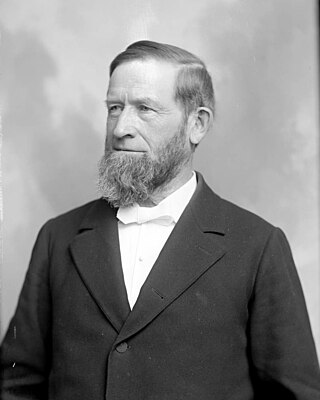
Henry White Warren (1831–1912) was an American Methodist Episcopal bishop and author. William Fairfield Warren was his brother.

Riverside Cemetery, established in 1876, is Denver, Colorado's oldest operating cemetery. More than 67,000 people are buried there, including 1,000 veterans.

Fairmount Mausoleum is a public mausoleum at Fairmount Cemetery in Denver, Colorado. The building was designed by architects Frederick E. Mountjoy and Francis W. Frewan. Constructed in 1929 and opened in 1930, the Fairmount Mausoleum contains the remains of more than 17,000 people and houses one of the largest stained glass collections in the state of Colorado.
